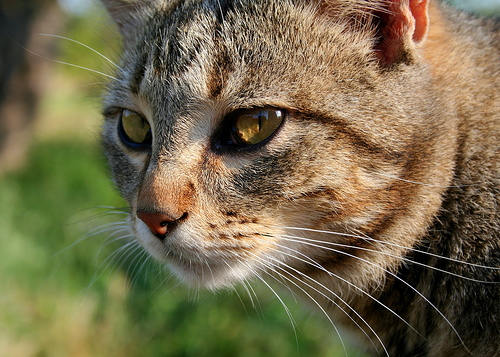
FIV, or “Feline AIDS,” is a virus that causes immunodeficiency disease in domestic cats throughout the world. The feline immunodeficiency virus belongs to the same family as HIV, the immunodeficiency virus of humans.
FIV has effects on all of the systems of the body as a result of the suppressed immune system. Cats that become infected with FIV suffer from numerous secondary infections and ultimately tend to have a shorter lifespan.
Is FIV very prevalent in cat populations?
The incidence of FIV in the healthy cat population is fairly low (1.5 to 3%), although this varies depending on geographical location. The likelihood of an animal becoming infected with FIV depends on a number of risk factors: age, gender, illness, and time spent outdoors.
1. Age: the prevalence of FIV infection increases with age – the average age at diagnosis is 5 years.
2. Gender: male cats, especially tomcats, are much more likely to contract FIV then females, because they tend to roam and get in fights with other cats.
3. Illness: the prevalence of FIV amongst ill cats is much higher (~ 9-15% of the population) than in healthy cats
4. Indoor vs. Outdoor Cats: indoor cats are much less likely to be infected than cats with access to the outdoors.
How do cats become infected with FIV?
The most common route of transmission is via saliva, especially through penetrating bite wounds that introduce the saliva deep into the tissues. Cats that exhibit territorial aggression are most at risk of infection. Transfer can also occur in the womb, from mother to kittens, although this is much less documented in cats.
It is possible to transfer infection via blood transfusion. Venereal transfer has not been documented. It is unlikely that the virus can be transferred by using the same water or food dish, or by mutual grooming.
Can people become infected with FIV?
Only cats carry FIV. There is no evidence to show that cats can transfer FIV to humans. It is important to consider that FIV-positive cats may carry other diseases that can be transferred to humans, such as Toxoplasma gondii (this is especially important for immune-suppressed owners).
How can I recognise the clinical signs of FIV?
FIV infections can go unrecognised for some time before diagnosis because the signs are so diverse. When the virus attacks the host’s immune system and weakens it, the body becomes susceptible to a range of secondary infections (e.g. bacteria, other viruses, fungi, etc.). The signs may also resemble FeLV (feline leukaemia virus), as FeLV also causes disease associated with immunodeficiency.
Approximately 3 weeks after infection, cats may show the primary phase of FIV infection, with signs of depression, enlarged lymph nodes (glands), and/or fever. The cat will then appear clinically normal until full-blown immunosuppression has developed. The clinical signs associated with a weakened immune system are variable, but are usually those of recurring infections:
• Chronic gingivitis, mouth sores, and bad breath
• Upper respiratory infections (e.g. cat flu)
• Chronic diarrhoea
• Skin infections
• Weight loss
• Diseases of the eye (uveitis, glaucoma)
• Abscesses
• Bladder infections
• Increased incidence of cancer (e.g. lymphosarcoma)
• Neurological signs or behavioural changes (e.g. aggression)
• Susceptibility to parasitic infection (e.g. demodecosis, toxoplasmosis, salmonellosis, haemobartonellosis)
How is FIV diagnosed?
Your veterinarian can diagnose FIV using an ELISA test that identifies FIV antibodies in the blood. This test is quick and easy, and can be done in the veterinary clinic. However, if the test does come back positive, follow-up testing should be performed to confirm the diagnosis. A certain percentage of FIV-positive cats will not test positive for disease.
This may be due to early infection, a failure to produce antibody to FIV, or a failure of the test system. Kittens born to FIV-positive mothers should not be tested before 3 months, as they may give a false positive due to antibodies consumed in their mother’s milk.
How is FIV treated?
As many of the drugs used to treat HIV in people are extremely costly and/or toxic to cats, veterinarians do not routinely choose to use antiviral drugs in cats. Instead, the secondary problems associated with the immunosuppression are treated. FIV-positive cats may require more veterinary visits in order to monitor for secondary diseases.
Treatment can include antibiotics, antifungals, high energy diets, and further supportive care. Unfortunately, for some cats that are in the terminal stages of the disease (wasting and severe infection or disease), euthanasia should be considered.
What is the prognosis for a cat diagnosed with FIV?
The progression of the disease varies from cat to cat. Some cats may go on to live for several years following a FIV-positive result. In general, however, the more severe and chronic the clinical signs are, the worse the prognosis. Once a cat is in the terminal stages of the disease, there life expectancy is 1 year or less.
How can I prevent my cat from contracting FIV?
The most effective means of preventing your cat from becoming infected with FIV is to have it neutered and to prevent it from fighting. Also, before introducing a new cat into a multiple cat household, always have it tested for FIV. There is a FIV vaccine available, but it has limited efficacy because there are multiple strains of the virus.
If you own a FIV-positive cat, it should be isolated from other uninfected cats. Preventing access of infected cats to the outdoors not only stops them from spreading FIV by fighting, but it also reduces the exposure of the cat to potential secondary pathogens.
(photo: fazen)